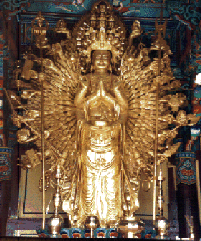|
||||||
|
Religion
Buddhism
Buddhism first arrived in Korea in the 2nd year (A.D. 372) of the reign of King Sosurim of the Goguryeo Kingdom. After its introduction, Buddhism exerted a powerful influence in the Baekje Kingdom and Silla Kingdom. Bulguksa Temple and Seokguram Grotto, which are designated as World Cultural Heritage sites by UNESCO, are Buddhist creations from the Silla Kingdom. Buddhism has exercised a far-reaching influence on Korean culture throughout its long history. The nation's invaluable Buddhist heritage abides in buildings, sculptures, paintings and handicraft.
Protestantism & Catholicism
Protestantism came to Korea after the signing of the Korean-American Treaty in 1882. Because Christianity challenged the basic values of Joseon society, its believers were subject to persecution in the early years, but as Christians took an increasingly active role in the anti-colonial struggle against the Japanese and churches promoted more educational opportunities, Christianity gained acceptance. |
|
|
Today Korean churches evangelize abroad, and approximately twenty five percent of the Korean population is Christian. Catholicism first came to Korea as a western scholarly pursuit. Korean tributary missions to the imperial court of China took an interest in Jesuit missionary books and brought them back to Korea. In 1784 the first Korean was baptized in Beijing and returned to Korea to set up a house of worship. Despite considerable persecution by the government, numerous people joined the Catholic Church. Presently, over two million people belong to the church.
Confucianism
Confucianism became a common philosophy in ancient Korea. When it came into contact with fundamental Korean sentiments, Confucianism brought about profound changes and exerted considerable influence on the Korean people. It has been an indispensable component of the Korean moral system, way of life and national laws. Confucianism, which was the major philosophy of the Joseon Dynasty, eventually gave rise to Silhak, or practical learning. Confucianism has deeply permeated the consciousness of Korean people and can be seen today in many forms, including two ceremonies that continue to day: Jongmyo Jerye, the royal ancestral service at Jongmyo Shrine and Seokjeon Daeje, the worship rites at the Seonggyungwan in honor of Confucius, his disciples, and other celebrated Chinese and Korean Confucian scholars.
Shamanism
Various shamanistic practices are deeply ensconced in Korean life. Shamanism were similar with folk beliefs from ancient times. It is closely related to the primitive cults which practiced communal rites for the gods of heaven, and which were uninfluenced by Buddhist tradition. One distinguishing characteristic of Korean shamanism is that it seeks to solve human problems through a meeting between humans and the spirits. This can be seen in the various types of shamanistic rites which are still widely practiced even today. |
|


